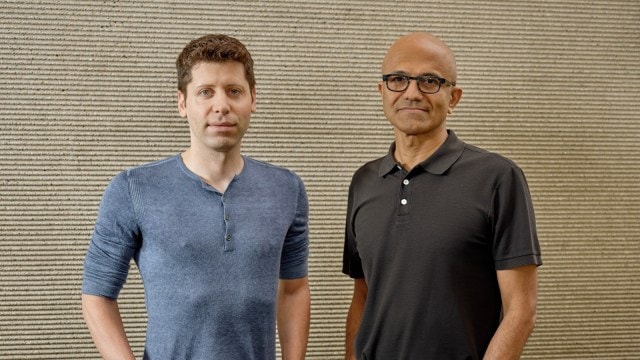Microsoft, OpenAI have their own secret version of what AGI means: Report
Artificial general intelligence has emerged as the potential escape hatch that could untangle the two companies.
 Sam Altman, left, one of the founders of OpenAI, and Satya Nadella, Microsoft’s chief executive, at the Microsoft Campus in Redmond, Wash. (Ian C. Bates/The New York Times)
Sam Altman, left, one of the founders of OpenAI, and Satya Nadella, Microsoft’s chief executive, at the Microsoft Campus in Redmond, Wash. (Ian C. Bates/The New York Times)While much of the AI community continues to fiercely debate what artificial general intelligence (AGI) actually means, OpenAI and its largest investor, Microsoft, seem to have quietly settled on a definition all along.
The two tech companies reached a consensus in 2023 that they would consider AGI to be achieved if an AI system generates at least $100 billion in profits, according to a report by The Information.
Microsoft and OpenAI are also reportedly negotiating several changes to their arrangement ahead of the ChatGPT-maker’s pivot to a for-profit company structure next year.
Over the years, Microsoft has invested more than $13 billion in OpenAI. It also exclusively provides cloud hosting services to OpenAI via Azure. But the paths of the two companies appear to be diverging. For instance, Microsoft has reportedly been integrating its in-house built AI model with Copilot 365 products in order to cut down costs and improve efficiency.
Meanwhile, OpenAI is gearing up to abandon its non-profit roots and become a for-profit company that would make it easier for the startup to raise funds and compete with other AI players.
How does AGI fit into this?
To put it simply, AGI is when computers become capable of thinking as well as or better than human beings. It has been speculated that such technology would be powerful and sophisticated enough to automate away millions of jobs, thus disrupting major parts of the economy.
However, in this context, AGI has emerged as the potential escape hatch that could untangle the two companies. This is because a provision in OpenAI’s contractual agreement with Microsoft states that the Windows developer would have to stop using its AI models if it cracks AGI.
Until one of OpenAI’s tools helps it collect $100 billion, Microsoft and other investors are reportedly entitled to a slice of its profits.







